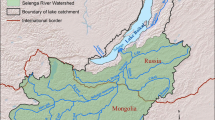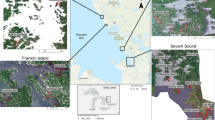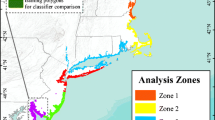Abstract
Expansion and contraction of floating and emergent vegetation due to fluctuating water levels has a direct impact on the amount of critical fish habitat in the coastal marshes of Georgian Bay, Lake Huron (Canada). Traditional mapping approaches developed for site-specific studies are too expensive to quantify such changes at the scale of Georgian Bay. Here, we use IKONOS images to develop a classification method (process-tree classification (PTC)), an automated, object-based, image-analysis approach that can produce regional maps of wetland habitat for south-eastern Georgian Bay (1466.7 Km). PTC discriminated among six wetland habitat classes (emergent, high-density floating, low-density floating, meadow, water, and rock) in four IKONOS satellite images with a mean accuracy of 87.4%. The PTC was then applied without modification to 17 other IKONOS images collected concurrently in 2002. Based on analysis of 50 randomly chosen wetlands in these images, we estimate that at 2002 water levels, at least 25% of an average wetland (6.5 ha) contains potential fish habitat. Although the PTC developed is specific to the 21 IKONOS images used in this study, the framework is transferable to satellite images acquired in other regions of Georgian Bay, and the approach itself could be applied to other large lakes.



Similar content being viewed by others
References
Ball H, Jalava J, King T, Maynard L, Potter B, Pulfer T (2003) The Ontario Great Lakes coastal wetland atlas: a summary of information (1983–1997). Environment Canada
Barbier EB, Koch EW, Silliman BR, Hacker SD, Wolanski E, Primavera J, Granek EF, Polasky S, Aswani S, Cramer LA, Stoms DM, Kennedy CJ, Bael D, Kappel CV, Perillo GME, Reed DJ (2008) Coastal ecosystem-based management with nonlinear ecological functions and values. Science 319:321–323
Brander LM, Florax RJGM, Vermaat JE (2006) The empirics of wetland valuation: a comprehensive summary and a meta-analysis of the literature. Environmental and Resource Economics 33:223–250
Chow-Fraser P (2006) Development of the Water Quality Index (WQI) to assess effects of basin-wide land-use alteration on coastal marshes of the Laurentian Great Lakes. In: Coastal wetlands of the Laurentian Great Lakes: health, habitat and indicators. In: Simon TP, Stewart PM (eds) Coastal Wetlands of the Laurentian Great Lakes: Health, Habitat, and Indicators. Authorhouse, Bloomington, pp 137–166
Chubey MS, Franklin SE, Wulder MA (2006) Object-based analysis of Ikonos-2 imagery for extraction of forest inventory parameters. Photogrammetric Engineering & Remote Sensing 72(4):383–394
Cohen J (1960) A coefficient of agreement for nominal scales. Educational and Psychological Measurement 20(1):37–46
Congalton RG (1991) A review of assessing the accuracy of classifications of remotely sensed data. Remote Sensing of Environment 37:35–46
Croft MV, Chow-Fraser P (2007) Use and development of the wetland macrophyte index to detect water quality impairment in fish habitat of Great Lakes coastal marshes. Journal of Great Lakes Research 33(Special Issue 3):172–197
Cvetkovic M (2008) Factors affecting macrophyte and fish distribution in coastal wetlands of Georgian Bay. Master’s Thesis. McMaster University
Dechka JA, Franklin SE, Watmough MD, Bennett RP, Ingstrup DW (2002) Classification of wetland habitat and vegetation communities using multi-temporal IKONOS imagery in southern Saskatchewan. Canadian Journal of Remote Sensing 28(5):679–685
DeCatanzaro R, Cvetkovic M, Chow-Fraser P (2009) The relative importance of road density and physical watershed features in determining coastal marsh water quality in Georgian Bay. Environmental Management 44(3):456–467
DeCatanzaro R (2010) Factors influencing coastal marsh water quality in Georgian Bay. Master’s Thesis. McMaster University, Ontario
Definiens (2007) Definiens Developer 7.0 Reference Book. Definiens®AG, Munchen, Germany
Dibble ED, Killgore KJ Harrel SL (1997). Assessment of fish-plant interactions. Miscellaneous Paper A-97-6. U.S. Army Engineer Waterway Experiment Station, Vicksburg, MS
Dillabaugh KA, King DJ (2008) Riparian marshland composition and biomass mapping using Ikonos imagery. Canadian Journal of Remote Sensing 34(2):143–158
Fournier RA, Grenier M, Lavoie A, Helie R (2007) Towards a strategy to implement the Canadian Wetland Inventory using satellite remote sensing. Canadian Journal of Remote Sensing 33(suppl 1):S1–S16
Fuller LM, Morgan T M, Aichele SS (2005) Wetland Delineation with IKONOS High-Resolution Satellite Imagery, Fort Custer Training Center, Battle Creek, Michigan. U.S. Geological Survey, Scientific Investigations Report 2006–5051, 8 p
Grenier M, Demers AM, Labrecque S, Benoit M, Fournier RA, Drolet B (2007) An object-based method to map wetland using RADARSAT-1 and Landsat ETM images: test case on two sites in Quebec, Canada. Canadian Journal of Remote Sensing 33(suppl 1):S28–S45
Hardisky MA, Gross MF, Klemas V (1986) Remote sensing of coastal wetlands. Bioscience 36(7):453–46
Hudon C (2004) Shift in wetland plant composition and biomass following low-level episodes in the St. Lawrence River: looking into the future. Canadian Journal of Fisheries and Aquatic Sciences 61:603–617
Ingram J, Holmes K, Grabas G, Watton P, Potter B, Gomer T, Stow N (2004) Development of a Coastal Wetlands Database for the Great Lakes Canadian Shoreline Final Report to: The Great Lakes Commission
Jacobus J, Webb PW (2005) Using fish distribution and behaviour in patchy habitats to evaluate potential effects of fragmentation on small marsh fishes: a case study. Journal of Great Lakes Research 31(Supplement 1):197–211
Jude DJ, Pappas J (1992) Fish utilization of Great Lakes coastal wetlands. Journal of Great Lakes Research 18(4):651–672
Laliberte AS, Rango A, Havstad KM, Paris JF, Beck RF, McNeely R, Gonzalez AL (2004) Object-oriented image analysis for mapping shrub encroachment from 1937 to 2003 in southern New Mexico. Remote Sensing of Environment 93:198–210
Landis JR, Koch GG (1977) An application of hierarchical Kappa-type statistics in the assessment of majority agreement among multiple observers. Biometrics 33(2):363–374
Lawson R (2004) Coordinating coastal wetlands monitoring in the North American Great Lakes’. Aquatic Ecosystem Health & Management 7(2):215–221
Leahy MG, Jollineau MY, Howarth PJ, Gillespie AR (2005) The use of Landsat data for investigating the long-term trends in wetland change at Long Point, Ontario. Canadian Journal of Remote Sensing 31(3):240–254
Lillesand TM, Kiefer RW, Chipman JW (2004) Remote Sensing and Image Interpretation, 5th edn. Wiley, Hoboken
Lougheed VL, Crosbie B, Chow-Fraser P (2001) Primary determinants of macrophyte community structure in 62 marshes across the Great Lakes basin. Canadian Journal of Fisheries and Aquatic Sciences 58:1603–1612
Mortsch L (1998) Assessing the impact of climate change on the Great Lakes shoreline wetlands. Climate Change 40:391–416
Mortsch L, Quinn FH (1996) Climate change scenarios of Great Lakes Basin ecosystem studies. Limnology and Oceanography 41(5):903–911
Navulur K (2007) Multispectral Image Analysis Using the Object-Oriented Paradigm. CRC Press, Taylor & Francis Group, Boca Raton
Niemi GJ, Kelly JR, Danz NP (2007) Environmental indicators for the coastal region of the North American Great Lakes: introduction and prospectus. Journal of Great Lakes Research 33(sp3):1–12
OMNR (1993) Ontario Wetland Evaluation System. Northern Manual. Ontario Ministry of Natural Resources (OMNR), No.50254
Poulin M, Careau D, Rochefort L, Desrochers A (2002) From satellite imagery to peatland vegetation diversity: how reliable are habitat maps? Conservation Ecology 6(2):16
Randall RG, Minns CK, Cairns VW, Moore JE (1996) The relationship between an index of fish production and submerged macrophyte and other habitat features at three littoral areas in the Great Lakes. Canadian Journal of Fisheries and Aquatic Sciences 53(Suppl 1):35–44
Rokitnicki-Wojcik D (2009) Use of remote sensing and GIS for wetland monitoring and assessment. Master’s Thesis. McMaster University
Sawaya KE, Olmanson LG, Heinert NJ, Brezonik PL, Bauer ME (2003) Extending satellite remote sensing to local scales: land and water resource monitoring using high-resolution imagery. Remote Sensing of Environment 88:144–156
Schowengerdt R (1997) Remote sensing: models and methods for image processing. Academic, Burlington
Scmidt KS, Skidmore AK (2003) Spectral discrimination of vegetation types in a coastal wetland. Remote Sensing of Environment 85:92–108
Seilheimer TS, Chow-Fraser P (2007) Application of the wetland fish index to northern Great Lakes marshes with emphasis on Georgian Bay coastal wetlands. Journal of Great Lakes Research 33(Special Issue 3):154–172
Silva TSF, Costa MPF, Melack JM, Novo EMLM (2008) Remote sensing of aquatic vegetation: theory and applications. Environmental Monitoring Assessment 140:131–145
Snell EA (1987) Wetland distribution and conservation in southern Ontario. Inland Waters and Land Directorate, Environment Canada, Burlington, Ontario
Statistics Canada (2006) Georgian Bay Township 2006 Community Profile. Available via http://www12.statcan.gc.ca/census-recensement/2006/dp-pd/prof/92-591/index.cfm?Lang=E Accessed 2 Oct 2009
Swain PH, Davis SM (1978) Remote Sensing: The Quantitative Approach. McGraw-Hill, West Lafayette
Ullah A, Rundquist DC, Derry DP (2000) Characterizing spectral signatures for three selected emergent aquatic macrophytes: a controlled experiment. Geocarto International 15(4):29–39
Wang L, Sousa WP, Gong P (2004) Integration of object-based and pixel-based classification for mapping mangroves with IKONOS imagery. International Journal of Remote Sensing 25(4):5655–5668
Wei A, Chow-Fraser P, Albert D (2004) Influence of shoreline features on fish distribution in the Laurentian Great Lakes. Canadian Journal of Fisheries and Aquatic Sciences 61:1113–1123
Wei A, Chow-Fraser P (2007) Use of IKONOS imagery to map coastal wetlands of Georgian Bay. Fisheries 32(4):167–173
Zhou W, Troy A, Grove M (2008) Object-based land cover classification and change analysis in the Baltimore metropolitan area using multitemporal high resolution remote sensing data. Sensors 8:1613–1636
Acknowledgments
This study could not have been carried out without funding and access to IKONOS imagery provided by Georgian Bay Forever (GBF). We thank the Georgian Bay Association (GBA), especially Mary Muter, who helped us gain access to the coastal wetlands and generously provided their cottages for us to stay in. Other funding for this research came from the Ontario Ministry of Natural Resources and the Natural Sciences and Engineering Research Council of Canada. We thank Maja Cvetkovic, Daniel Rokitnicki-Wojcik, Lyndsay Smith, Henry Heiser, and Anhua Wei for helpful suggestions and comments, and everyone in the Chow-Fraser lab who helped collect field data.
Author information
Authors and Affiliations
Corresponding author
Electronic supplementary material
Below is the link to the electronic supplementary material.
ESM 1
(DOC 8670 kb)
Rights and permissions
About this article
Cite this article
Midwood, J.D., Chow-Fraser, P. Mapping Floating and Emergent Aquatic Vegetation in Coastal Wetlands of Eastern Georgian Bay, Lake Huron, Canada. Wetlands 30, 1141–1152 (2010). https://doi.org/10.1007/s13157-010-0105-z
Received:
Accepted:
Published:
Issue Date:
DOI: https://doi.org/10.1007/s13157-010-0105-z




